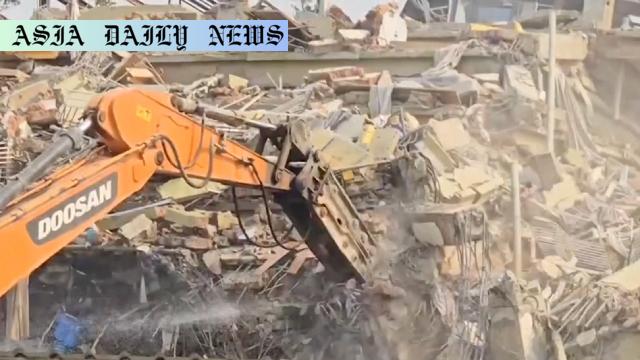Earthquake: UN says the magnitude-7.7 quake in Myanmar left 2.5 million tons of debris, with over 60,000 people displaced in affected areas.
The magnitude-7.7 earthquake in Myanmar caused catastrophic damage, leaving over 3,700 people dead and 2.5 million tons of debris.
UN reports show over 60,000 people have been displaced, with infrastructure like roads, homes, and health facilities heavily impacted.
Global aid has been requested to assist recovery efforts and support ongoing humanitarian needs in the affected regions.

Widespread Devastation from Myanmar’s Earthquake
On March 28, Myanmar experienced a catastrophic magnitude-7.7 earthquake, leaving a trail of unprecedented devastation. This disaster has resulted in the loss of more than 3,700 lives, and over 120 people are still unaccounted for. According to reports, the earthquake significantly damaged over 10,000 homes and public buildings, alongside 128 health facilities, leaving critical infrastructure in ruins. The northwestern Sagaing region, along with several parts of central Myanmar, bore the brunt of this disaster. Local communities are reeling, with over 60,000 individuals forced into temporary shelters. Essential services, including roads and water supplies, have been compromised, making recovery even more challenging.
Analyzing the Humanitarian Crisis
The human toll of the earthquake extends far beyond the immediate casualties. Thousands of displaced families are struggling to access basic necessities, such as food, clean water, and medical support. The United Nations, through its Development Programme (UNDP), has called for international attention and comprehensive support to address the scale of the humanitarian crisis. Temporary displacement camps have been set up, yet these facilities are overstretched, unable to accommodate all those in need. The damaged infrastructure presents logistical challenges for both aid distribution and rebuilding efforts.
The Need for Global Solidarity
The scope of destruction in Myanmar underscores the urgent need for global solidarity. The UN estimates that 2.5 million tons of debris are scattered across the affected areas, making cleanup and reconstruction daunting tasks. Humanitarian organizations warn that without sufficient aid, the region may face long-term consequences, including economic and social instability. Regional and international governments have been urged to provide immediate financial support, technical assistance, and resources for rebuilding efforts. The involvement of the international community is critical to ensuring that Myanmar does not face this tragedy in isolation.
Rebuilding a Resilient Myanmar
Despite the hardships, the people of Myanmar have shown incredible resilience. From local volunteers organizing relief efforts to the international community uniting in solidarity, there is hope that the nation can rebuild stronger and more resistant to future disasters. Key priorities for recovery include restoring health and education facilities, rebuilding homes, and enhancing disaster preparedness systems to mitigate future risks. As Myanmar navigates this difficult path toward recovery, sustained international support will be pivotal in ensuring long-term success and stability.



Commentary
The Lingering Impact of Myanmar’s Earthquake
Myanmar’s earthquake should serve as a stark reminder of nature’s unpredictability and the critical importance of disaster preparedness. The magnitude-7.7 quake has left tens of thousands homeless, disrupted essential services, and claimed thousands of lives. This tragedy underscores the vulnerability of communities in disaster-prone regions and the urgent need for robust infrastructure and preparedness mechanisms. Situations like these should catalyze global conversations about climate resilience and disaster-readiness efforts.
The Role of International Aid
Global aid plays a vital role in helping nations recover from catastrophic events. In Myanmar’s case, international efforts will determine how quickly and effectively the affected areas can heal. The massive debris removal and rebuilding will require funds, expertise, and collaboration between various stakeholders. However, there is always a risk of donor fatigue when it comes to prolonged recovery efforts. Garnering long-term commitments from international organizations and governments is key to ensuring successful rehabilitation.
Hope Amidst Tragedy
Despite the scale of destruction, there is hope for Myanmar’s recovery. Unified efforts from local and international stakeholders can rebuild not only the destroyed structures but also foster resilient communities. Providing adequate resources, addressing the healthcare and housing crisis, and implementing rigorous disaster-prevention systems post-recovery are forward steps toward ensuring that Myanmar emerges stronger. Above all, recognizing the human element behind every statistic—families, lives, and dreams impacted—is what makes a tragedy like this more than just a headline, and a call to action for all of us.